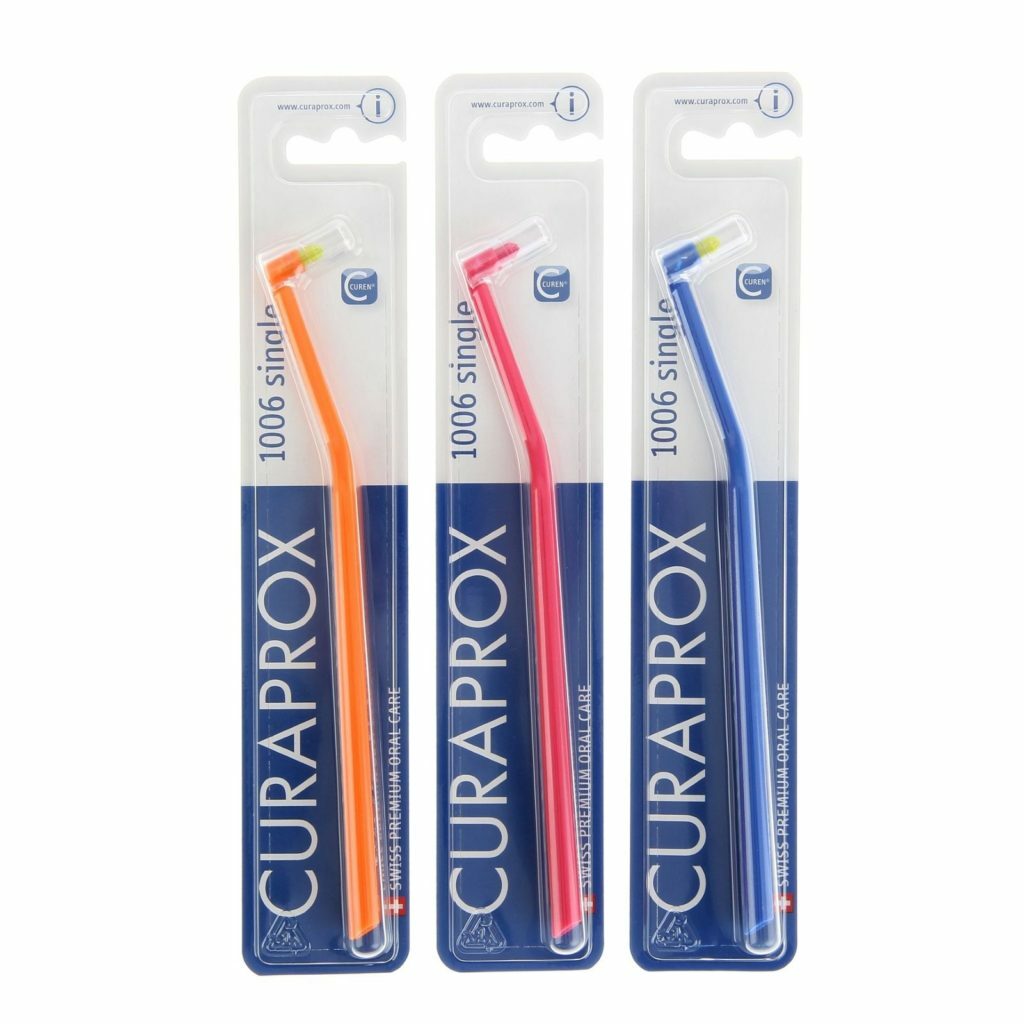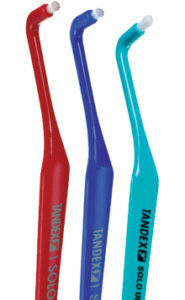 Dentistry has long reached a new level of service in many ways thanks to the latest developments. In addition, people are increasingly monitoring the oral hygiene and use all available innovations.
Dentistry has long reached a new level of service in many ways thanks to the latest developments. In addition, people are increasingly monitoring the oral hygiene and use all available innovations.
Conventional brushes have long been not enough: in addition, toothpicks, rinses, etc. are used. But every year, new means of care are invented, and one of these innovations is a single-tooth toothbrush. As already clear from the name itself, its distinctive feature is one single bundle of bristles.
First of all, this form is distinguished by an unusual form: on a thin long handle at the end perpendicular to the base there is a small bundle of bristles. The effect of the application is similar to the usual tooth brushing and toothpick at the same time.
This means that it is able to penetrate hard-to-reach places for ordinary cleaning devices. A person without special problems with teeth is not very familiar with such a device, but the owners of various types of orthodontic structures and systems in the mouth know about the existence of single-beam toothbrushes for brackets.
A similar method of cleaning teeth is known for a long time, and it takes its origin in Africa, where local tribes used tree branches unbundled from one edge. For this, the branches were cut into thin strips, and one side was well soaked in water.
It is interesting that in India a similar method of hygiene is still applied. The modern "follower" is created on the same principle, but already with the help of the achievements of modern science and industry.
Contents
- Main features and features
- head
- handle
- handle Indications for use
- Dental and orthodontic systems
- Pathology of the tooth row
- Advantages and disadvantages
- Best models of beam brushes
- Usage rules
- How to choose a single-beam brush
- Brush head and its dimensions
- Fiber material
- Monobrush handle
- Rigidity of bristles
- Mono-brush maintenance
- Price
Key features and features of
Not only the appearance distinguishes this innovation, but also the structure of each of its elements: the cleaning head, the beam and the handle:
Head
The head is small and round in shape. It is presented in 2 sizes, as well as standard brushes: for children the diameter is up to 7 mm, and for adults - up to 11 mm.
Vorsinki
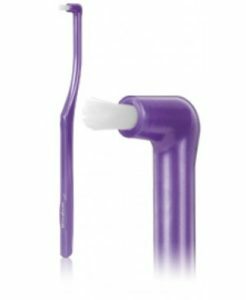
Made of natural or synthetic material. It is preferable to use natural fibers for use, but they are more expensive. Synthetic made of polyurethane and nylon.
The standard width of the villi is less than 0.2 mm, and the ends are rounded to reduce the risk of injury to the mucous membranes.
In addition, the bristles differ in length: for normal cleaning models with a length of up to 6 mm are suitable, and for orthodontic constructions - the length should be 9 mm. Also distinguish 5 degrees of rigidity: from extra hard to very soft. Different stiffness is used for different ages, as well as on the presence of certain crowns or bracket systems.
Handle
Specially made thin and long, so that you can get to the farthest teeth, for example, "wisdom" without any inconvenience. For the same reason, they also release curved handles. For convenience and fixation of a thin handle in the hand, the mono-beam models often provide silicone overlays.
Features that mono-brushes possess, in contrast to the standard ones:
- Spot treatment - is necessary in case there is inflammation on the mucosa or a damaged area of any tooth. A small bundle of bristles makes it easy to avoid a sick site and its additional trauma.
- Excellent cleansing of the area near the gums, which is difficult to clean.
- Small sizes are especially suitable for oral hygiene in young children.
- Suitable for cleaning various crowns and bracket systems.
- Prevents the formation of plaque due to the qualitative cleaning of each tooth.
- Used with or without toothpaste.
Possessing such distinctive features allowed single-beam models to gain popularity quickly enough.
Indications for use
The beam toothbrush has a wide range of applications. Indications for its use can be divided into several groups:
Dental and orthodontic systems
Presence of crowns, implants, braces, prostheses. Because of their fixed structure and a large number of fasteners, there are often serious problems with cleaning them. In addition, after the installation of such systems, mucous surfaces and tooth tissues become very sensitive. In this case, the beam model provides gentle and high-quality care, as well as the integrity of the installed structure.
Dental pathology
Incorrect bite and location of teeth, their crowding, wide gap between them, etc. Such problems do not provide an opportunity to clean well, for example, the interdental space, which causes the development of caries. Using a standard brush along with a single-beam brush allows you to solve this problem.
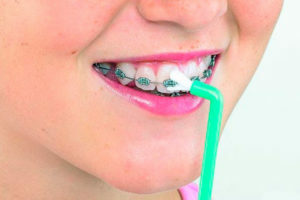 For additional reasons, the use of a toothbrush can be attributed to various periodontal diseases or injury, such as periodontitis or gingivitis.
For additional reasons, the use of a toothbrush can be attributed to various periodontal diseases or injury, such as periodontitis or gingivitis.
With a healthy oral cavity, this model provides quality care for hard-to-reach places.
A dense small bundle of villi can effectively remove the existing contaminants from the entire surface of the tooth without damaging the mucous membrane and the structures installed in the mouth.
Advantages and disadvantages of
Advantages in using such a model are obvious, which explains the rapid growth of its popularity:
- qualitative purification from bacterial plaque;
- convenience and ease of use;
- no contraindications;
- the structure of the device and its bristles provide excellent cleansing of prostheses, crowns and various orthodontic devices;
- point cleaning, which provides gentle care in the presence of injuries and inflammations;
- is a large model range for both adults and children.
As with most devices, this kind of has some drawbacks:
- is an auxiliary option, so the use of a standard brush is also necessary;
- because of the small size the cleaning procedure takes quite a long time.
As you can see, there are very few shortcomings, but oral health is worth the time spent on it.
The best models of beam brushes
Among the manufacturers of single-beam toothbrushes, the Curaprox brand is especially known - its line can boast a wide variety of models. Among them, the most popular is the Сuraprox CS 1009 Single &Sulcular.
Also it is possible to note and other popular variants from other manufacturers:
- Miradent I-Prox P;
- Jordan Interbrush;
- Edel White.
Rules for using
An unusual device has some features of use. If you follow the instructions, you can get the most positive result:
- Before application, the villi is wetted with water, which provides a soft glide over the surface of the teeth.
- Conditionally all the teeth are divided into groups, enough for 4, and begin cleaning from the farthest areas.
- The cleaning head should be positioned at an angle of 45 ° to the tooth surface to be treated.
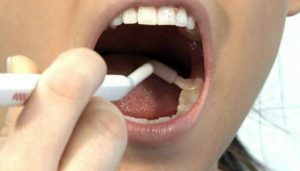
- The cleansing process begins at the very base of the tooth near the gum, with the direction of movement from the gum to the cutting tip. Movements are made in a circle sweeping. To apply special efforts on pressure it is not necessary - it can lead to a trauma mucous.
- In this way, clean all surfaces of the tooth from the inside and outside, while carefully cleaning the interdental space.
- The last step cleans the cutting surface of the tooth, making some effort for better quality.
The average time given for each tooth should be at least 10 seconds.
How to choose a single-beam brush
Such an interesting model of hygiene means is not well known, so there can often be minor problems with the selection of suitable options. Another criterion is a rather large assortment. The main criteria for distinguishing single-beam models are:
Brush head and its dimensions
Preference should be given to models with a round-shaped head, without corners and cusps. Children's size - up to 7 mm, adult - up to 12 mm.
Fiber material
Fibers can be natural or artificial. Natural - softer and there is no risk of traumatization of the mucous surface.
It is used quite rarely due to obvious shortcomings:
- high price;
- quick bristle wear;
- accumulation on villi and between them the remains of plaque and food, which leads to the development of bacteria.
The artificial material is more wear-resistant, its rigidity is higher, and the price is lower.
The length of the villi varies from 6 to 9 mm, the minimum used for children or healthy teeth, and the maximum - for cleaning the braces and crowns.
Handle of a monobrush
Handles of such model are thin enough, therefore are not always convenient in a hand. A more practical option will be models equipped with silicone or rubber pads.
Rigidity of bristles
Stiffness is important when choosing, so it's worth paying special attention to. Distinguish the following degrees:
- Sensitive or very soft contains villi 0.1 mm thick. Such a model can not damage the tissues, but also is not able to clean the surface of the teeth very well. The main application is for children from 2 to 5 years old.
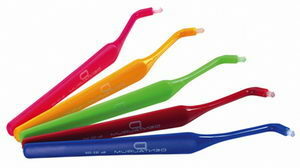
- Soft or soft is also recommended for children, but at the age of 4-10 years. The thickness of the hairs reaches 0.12 mm. This model is recommended for adults with gum disease and oral cavity, as well as for pregnant women in cases of hypersensitivity to gums and enamel. In addition, they perfectly clean the braces and other structures in the mouth.
- Medium or medium stiffness of hairs is used for daily care and prevention of superficial caries. The thickness of the villi reaches 0.16 mm.
- Hard or stiff has a villi thickness of 0.17 mm and is recommended for people who are prone to the formation of pigmented plaque and tartar. With such problems, stiff bristles are excellent.
- Extra-hard or very stiff bristles are not used for dental care, but are designed specifically for cleaning removable orthodontic structures.
Among all the variety of products on the market today, you can choose what meets the needs.
Caring for a single brush
Like any toothbrush, a single-beam model needs some care:
- After each application, it is necessary to wash the bristles with hot, but not boiled water - boiling water can deform the fibers.
- Over time, on the bristles accumulate and multiply bacteria, so at least 1 time in 7-10 days treatment with antibacterial agents is necessary. It can be chlorhexidine or a specially designed solution. The best method of disinfection is soaking in such a solution for up to several hours.
- Storage should be carried out in a special container or holder, in the position - head up. Joint storage with other brushes, for example, in glasses can lead to active development of bacteria.
- If suddenly the device was used in the period of infectious diseases, after recovery it should be replaced with a new one.
- The toothbrush for teeth should be changed every 3 months.
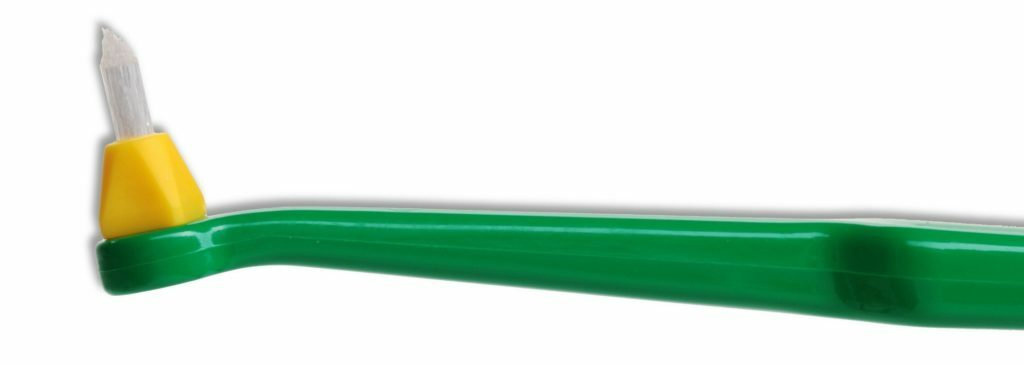
The necessary hygiene care not only ensures the maximum life of the device, but also avoids some problems, for example, the development of inflammations on the mucosa.
The cost of
In Russia it is possible to buy models from different manufacturers, from their fame and quality of goods, the price of beam toothbrushes also depends. We can conditionally allocate a minimum and a maximum price: from 150 to 1000 rubles. In addition to the brand, the design of the model also influences: there are standard samples, as well as copies with interchangeable heads. The ability to replace the head will cost when buying about 400-700 rubles. There are even two-sided models. Their price starts, as well as the standard options, from 150 rubles.
Reviews about a single-use toothbrush suggest a lot of positive results from the application. Particularly there is a possibility to clean the bracket-systems and other structures qualitatively, caring for which often causes serious problems for its owners. And also convenience in use in young children, due to the miniature size of the cleaning head.
Thus, in order to maintain oral health, there are many ways, and using a single-beam toothbrush as an auxiliary is one of them.

